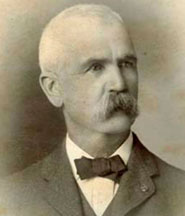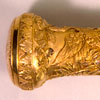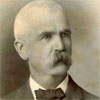
| A. Title: William T. Rigby and His Walking Cane |
||||||||||
|
||||||||||
| B. Overview of this Collection-Based Lesson Unit Plan |
||||||||||
|
||||||||||
| C. Museum Collections, Similar Items and other Materials Used in this
Lesson Unit Plan |
||||||||||
| The museum objects featured here were recovered from the U.S.S. Cairo, a Civil War ironclad gunboat in the "Brown Water" navy. On December 12, 1862, in the Yazoo River north of Vicksburg, Cairo struck two underwater torpedoes and sank in 12 minutes, with no loss of life. Preserved by mud and silt, the Cairo sat on the bottom of the river for 102 years. She was raised in 1964 and was later restored along with many of the objects that were found aboard. The recovered objects give a unique window into daily life and leisure time of Union officers and sailors during the Civil War. | ||||||||||
|
||||||||||
| D. National Educational Standards |
||||||||||
| Era 5- Civil War and Reconstruction (1850-1877) NSS-USH.5-12.5 Understands the course and character of the Civil War and its effects on the American people Nl-ENG.K-12.3: Evaluation Strategies NL-ENG,K-12.4: Communication Skills NL-ENG.K-12.5: Applying Knowledge Visual Arts Content Standard 1-Understanding and applying media, techniques and process Content Standard 2-Using knowledge of structures and functions Content Standard 3-Choosing and evaluating a range of subject matter, symbols and ideas Content Standard 4-Understanding visuals in relation to history and cultures Content Standard 5-Reflecting upon and assessing the characteristics and merits of their work and the work of others [Back to top] |
||||||||||
| E. Student Learning Objectives |
||||||||||
|
||||||||||
| F. Background and Historical Context |
||||||||||
William Titus Rigby was born on November 3, 1840, in Red Oak Grove, Iowa, near Tipton in Cedar County. He was the first born of four children. His families were devout Methodists who believed that the blessings of liberty should be enjoyed by all of God’s creatures. His father was opposed to the war due to religious beliefs and paid $20.00 in April 1861 to the troops so William would not have to enlist. William was anxious to enlist and saddened that he was unable to do so. In the summer of 1862 he enlisted after Lincoln issued a call for 300,000 additional men. Rigby entered into service with conviction and a strong faith in God. He assisted in enrolling volunteers to make Co. B, 24th Iowa Infantry. Three of his cousins also enrolled in Co. B. 24th Iowa Infantry. They were known as the Red Oak Boys. Rigby commanded the respect of those he knew. All the men from Red Oak Grove knew him as an honest, fair and decent man. He was elected Second Lieutenant on July 22, 1862. In the spring of 1863 the 24th Iowa was assigned to the XIII Corps and ordered to join the Army of the Tennessee under Maj. Gen. Ulysses S. Grant operating against Vicksburg. They did not participate in with the May 19 or 22 assaults on Vicksburg. They entered into duty late in the siege. After the surrender of Vicksburg on July 4, 1863 the regiment marched on to Jackson and participated in the siege of Mississippi’s capital city. They returned to Vicksburg for a rest. Rigby’s military career continued and he attained rank of Captain. It is said that Captain Rigby and the Red Oak Boys had faithfully performed duty and demonstrated qualities of veteran soldiers. After the war he attended Cornell College in Mount Vernon, Iowa, graduating in 1869. He married Eva Cattron in 1869 and they had three children. He was deeply involved with veterans’ affairs. In 1895 he was elected secretary of Vicksburg National Military Park Association. In 1899 he became the park’s resident commissioner. He was very involved in the planning and organization of the Vicksburg National Military Park. In 1902 he was chairman of the Vicksburg National Military Park. He died in 1929 and was buried in the national cemetery at Vicksburg. Significance of the Surrender Oak: On July 3, Grant demanded unconditional surrender of Confederate troops. Grant did not want to have to feed 30,000 hungry Confederates in Union camps and offered to parole all prisoners. Considering their destitute state he never expected them to fight again. Surrender terms were discussed beneath an old oak tree. The oak tree became known as the Surrender Oak. The soldiers knew the importance of the agreement made under the oak tree and started taking parts of the tree and making trophies. There is nothing left of the Surrender Oak. Every part of the tree including its roots was taken and used as reminders of what took place under the tree. |
||||||||||
| G. Vocabulary |
||||||||||
Unique-being the only one, distinctly characteristic, unusual |
||||||||||
| H. Teacher Tips |
||||||||||
| Download and laminate photograph of Rigby’s Walking Cane catalog number VICK 3603 for use in activity. Collect materials in advance of constructing the walking canes. Lesson plan can be adapted to accommodate the appropriate grade for Teachers. [Back to top] |
||||||||||
| I. Lesson Implementation Procedures |
||||||||||
Activity One Activity Three
Have students compare the reason they thought they were bringing a walking cane and the significance of William T. Rigby’s cane. Activity Six –Making a Mini Museum The students will make their own cane using rolls of gift wrap paper, paint, construction paper or anything else they want to use to make a presentation walking cane. This cane must represent the person who is in the photograph they brought to school. They need to find out important facts about that person and find a way to include them on the cane. |
||||||||||
| J. Evaluation/Assessment for Measurable Results |
||||||||||
| Students should expect to be evaluated on participation levels and their full involvement with activities. They will also be evaluated on journal entries, group presentations, charts, test, and making of presentation cane. They will also be evaluated on their overall understanding of William T. Rigby’s role in the establishment of the Vicksburg National Military Park and the significance of his walking cane. [Back to top] |
||||||||||
| K. Extension and Enrichment Activities |
||||||||||
Canes will be put in a mini museum and presented to the people they represent in a reception in the classroom. |
||||||||||
| L. Resources |
||||||||||
http://www.lib.uiowa.edu/spec-coll/MSC/ToMsc100/MsC82.htm |
||||||||||
| M. Site Visit |
||||||||||
|
Pre-visit- Before the visit have students visit the Vicksburg National Military Park website. They can go through the virtual exhibit. Have a few brochures from the park to let the students familiarize themselves with how the park is laid out and its operations. Call the park and schedule a visit. They can have a park guide specifically for your group.
Site-visit- At the Vicksburg National Military Park, have each student find one object of interest. When the students find their object they should use the “How to Read an Object” chart. Post-visit- Have the students write down their impressions of the park. They could write about the most surprising thing they learned, the most unusual thing they saw, the thing they liked the least etc. [Back to top] |
||||||||||
| N. Charts, Figures and other Teacher Materials |
||||||||||
|
Study Sheet [Back to top] |


